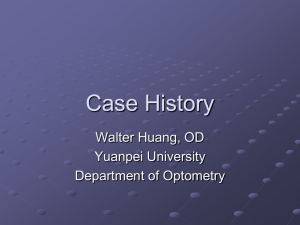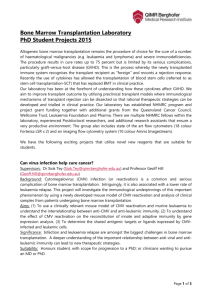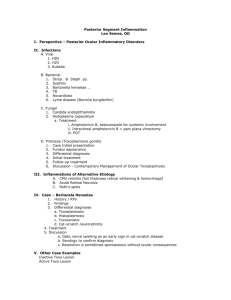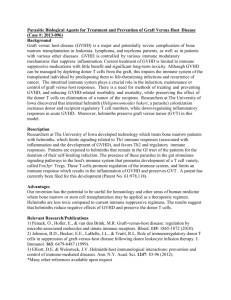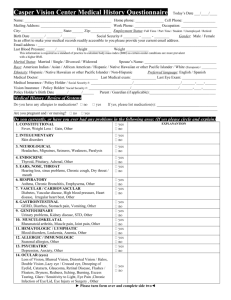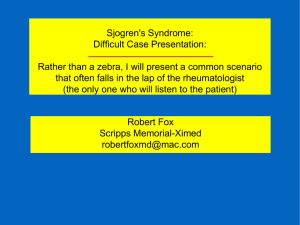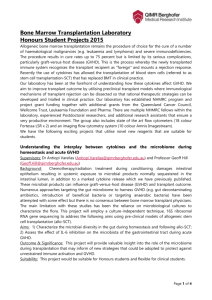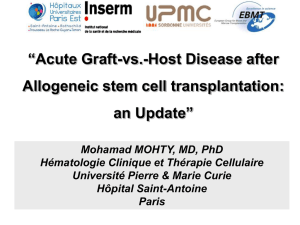Ophthalmology Times Resident Writer`s Award Program A
advertisement
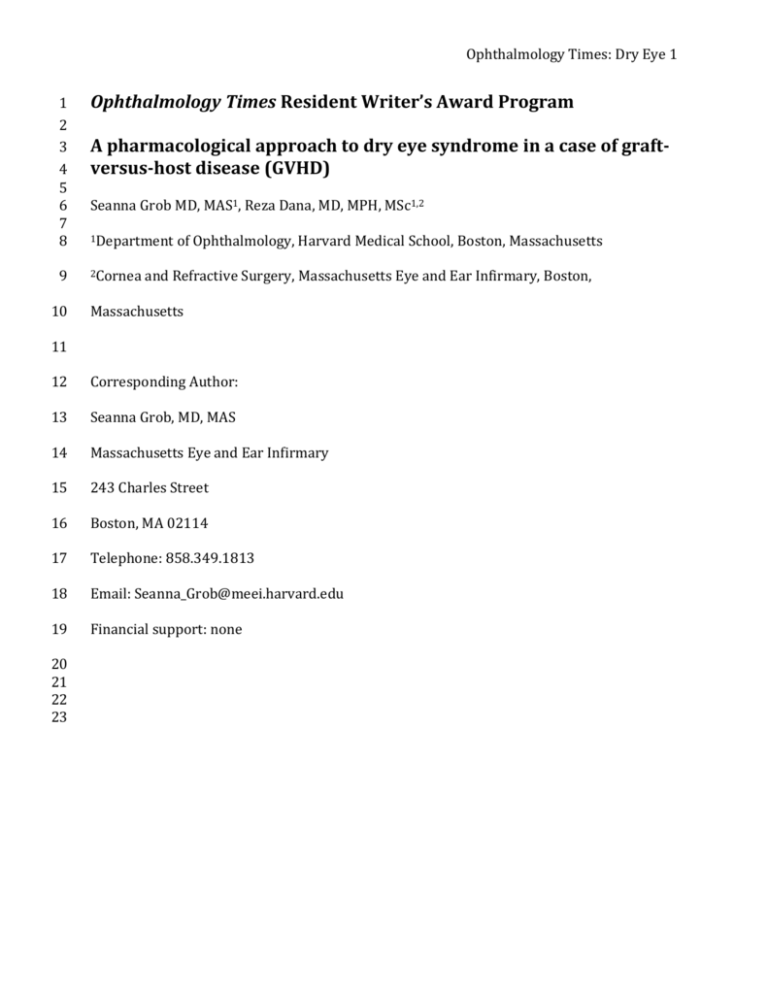
Ophthalmology Times: Dry Eye 1 1 2 3 4 5 6 7 8 Ophthalmology Times Resident Writer’s Award Program 9 2Cornea 10 A pharmacological approach to dry eye syndrome in a case of graftversus-host disease (GVHD) Seanna Grob MD, MAS1, Reza Dana, MD, MPH, MSc1,2 1Department of Ophthalmology, Harvard Medical School, Boston, Massachusetts and Refractive Surgery, Massachusetts Eye and Ear Infirmary, Boston, Massachusetts 11 12 Corresponding Author: 13 Seanna Grob, MD, MAS 14 Massachusetts Eye and Ear Infirmary 15 243 Charles Street 16 Boston, MA 02114 17 Telephone: 858.349.1813 18 Email: Seanna_Grob@meei.harvard.edu 19 Financial support: none 20 21 22 23 Ophthalmology Times: Dry Eye 2 1 2 Abstract: 65-year-old male with history of multiple myeloma and acute myeloid leukemia 3 now status post multiple bone marrow transplants (including two allogeneic and 2 4 autologous transplants) presented for evaluation of dry eye symptoms and photophobia 5 that worsened after stopping oral Tacrolimus, which he was taking for graft-versus-host 6 disease (GVHD) prophylaxis. The patient’s visual acuity was 20/50- in the right eye and 7 20/100 in the left eye. Schirmer’s test was zero in both eyes. He had corneal fluorescein 8 staining (National Eye Institute grading scale) of 12/15 in the right eye and 10/15 in the 9 left eye with elevated subepithelial opacifications consistent with Salzmann degeneration. 10 The patient was treated with punctual cauterization, anakinra 2.5% three times a day, 11 autologous serum tears, and Boston Sight® PROSE lenses. The patient also used lubrication 12 eye drops during the day and ointment at night. After close evaluation for a year, with the 13 PROSE lenses in place, his vision improved to 20/25-3 in the right eye and 20/20-3 in the 14 left eye. The treatment of dry eye disease in the setting of GVHD is complicated and 15 requires close monitoring by an experienced cornea specialist and often needs a 16 combination of multiple available treatments to control symptoms and disease 17 progression. Ophthalmology Times: Dry Eye 3 1 2 History: A 65-year-old male was referred to the Cornea and Refractive Surgery Clinic at 3 Massachusetts Eye and Ear Infirmary for evaluation of decreased vision, sensitivity to light, 4 and the sensation of dryness in both eyes. 5 The patient had a past medical history of multiple myeloma diagnosed 22 years 6 prior when he presented with back pain and widespread bone disease. He underwent 7 initial treatment of Vincristine-Dactinomycin-Cyclophosphamide (VAC) chemotherapy and 8 then his first autologous hematological stem cell transplant (auto-HSCT) a year later. After 9 several years, he had his second auto-HSCT. He then received thalidomide-based therapy 10 followed by an allogeneic hematological stem cell transplant (allo-HSCT) from his sister. 11 Thereafter, he was treated with bortezomib and went into remission. Follow up treatments 12 included lenalidomide, bortezomib, and dexamethasone over the next 5 years. 13 Unfortunately, he developed therapy-related acute myeloid leukemia three years prior to 14 presentation, but successfully underwent an allo-HSCT from an unrelated donor. The 15 patient did remarkably well throughout these treatments. 16 However, the patient noticed worsening symptoms of dry eyes after stopping 17 Tacrolimus, which he was taking for Graft-versus-host disease (GVHD) prophylaxis. He 18 previously tried punctual plugs and several years prior had undergone lower punctal 19 cautery in both eyes. He was currently using prednisolone 1% every two hours and Refresh 20 PM (Allergan, Irvine, CA) every two hours in both eyes. 21 22 Examination: Ophthalmology Times: Dry Eye 4 1 At this time the patient’s visual acuity was best corrected to 20/200 with pinhole to 2 20/50- in the right eye and 20/200 with pinhole to 20/100 in the left eye. The patient’s 3 conjunctiva was injected and he had a low tear meniscus and rapid tear break up in both 4 eyes. He had corneal staining (National Eye Institute grading scale) of 12/15 in the right 5 eye and 10/15 in the left eye with elevated subepithelial opacifications consistent with 6 Salzmann degeneration, more on the right than the left eye. Schirmer’s test was zero in 7 both eyes. The patient had intraocular lens implants in both eyes. The pupils, motility, 8 intraocular pressure and dilated fundus exam were unremarkable. 9 10 Diagnosis and Discussion: 11 Given the patient’s clinical history and examination, the likely diagnosis was Ocular 12 GVHD in the setting of a recent allo-HSCT. GVHD is a common complication after allogeneic 13 transplantation and frequently affects the skin, gastrointestinal tract and the liver.(1) 14 Approximately 40-60% of patients who have received allo-HSCT are affected by ocular 15 GVHD.(2-5) Both conjunctival (hyperemia, serosanguinous discharge, pseudomembranes, 16 fibrovascular membranes or cicatricial changes in chronic) and corneal (dry eye syndrome, 17 epitheliopathy, corneal epithelial sloughing) findings occur in ocular GVHD.(6) 18 Pharmacologic agents often used for the prophylactic treatment of systemic GVHD 19 are calcineurin inhibitors, including cyclosporine and tacrolimus, combined with 20 methotrexate.(7, 8) Our patient specifically noticed worsening symptoms of dry eyes after 21 the tacrolimus was discontinued. Fortunately, he never developed systemic symptoms of 22 GVHD. However, if other systemic GVHD findings are present, therapy commonly includes 23 systemic steroids.(6) Ophthalmology Times: Dry Eye 5 1 In contrast, increasing systemic immunosuppression or the cumulative steroid dose 2 is not recommended for the treatment of ocular GVHD. Treatment options focus on 3 lubrication and tear film preservation, prevention of tear evaporation, reduction in 4 inflammation, and epithelial support.(6) Topical lubrication with non-preserved phosphate- 5 free tears is almost always combined with other modalities.(6) Therapies for tear 6 preservation include punctual occlusion or thermal cautery, which can reduce 7 supplemental tear dependence.(9) Also, the mucolytic properties of Acetylcysteine (5-10%) 8 eye drops may be utilized in patients with adherent ocular surface filaments and oral 9 secretagogues (pilocarpine or cevimaline) may contribute to the stimulation of tear flow.(6) 10 Tear film instability and evaporative dry eye syndrome is closely associated with 11 meibomian gland dysfunction (MGD). Treatments include warm compresses, lid hygiene, 12 topical ointments such as erythromycin, tetracycline antibiotics (doxycycline or 13 minocycline) and macrolides (azithromycin) for their anti-inflammatory effects, and flax 14 seed or fish oil supplements.(6) 15 Reduction in the inflammatory component of ocular GVHD and dry eye syndrome is 16 also a key component of treatment. Topical cyclosporine (CsA) acts by inhibiting T-cell 17 proliferation and their production and release of lymphokines and has shown some success 18 in refractory ocular GVHD.(9-11) High frequency (greater than twice daily) 0.05% CsA has 19 shown improved symptoms and clinical signs of ocular disease.(12) Topical steroids may 20 also be beneficial due to their anti-inflammatory properties, but ocular side effects limit 21 their use, especially in patients with a history (including family history) of ocular 22 hypertension or glaucoma. Short-term, pulse steroids can have therapeutic potential in 23 acute disease, but are not the optimal approach for long-term disease control. Off-label use Ophthalmology Times: Dry Eye 6 1 of topical 2.5% interleukin-1 receptor antagonist (IL-1Ra) (anakinra, formulated by the 2 Massachusetts Eye and Ear Infirmary pharmacy department, MA) has also shown 3 promising results.(6, 13, 14) Systemic tacrolimus (FK506), a calcineurin inhibitor, has a 4 beneficial effect in some cases of ocular GVHD, most likely by improving tear film 5 production. Topical use is still in its early stages of evaluation, but has shown some clinical 6 evidence of efficacy in dry eye disease.(15-17) Additionally, several other potential 7 medications with anti-inflammatory properties are in the pipeline for use in dry eye 8 disease. 9 Epithelial support can be achieved with autologous serum eye drops and special 10 contact lenses. Autologous serum eye drops have shown beneficial effects in the treatment 11 of severe dry eye related to GVHD.(18, 19) The serum contains epithelioptrophic growth 12 factors and other components essential for the health of the epithelial surface. However, 13 use of serum tears requires specialized centers that can follow the regulations for drugs 14 and blood products. Contact lenses, including bandage soft contact lenses, scleral lenses, 15 and PROSE (prosthetic replacement of ocular surface ecosystem), have shown beneficial 16 therapeutic effects in patients with severe dry eye and GVHD and can be an effective 17 addition to the treatment plan.(20-24) 18 Our patient was followed closely over the following year. Over this time, the topical 19 steroids were tapered to reduce the cumulative dose of steroid. The upper puncta were 20 cauterized during this period. Topical interleukin-1 receptor antagonist 2.5% three times a 21 day was started in both eyes. Subsequently, the patient was started on autologous serum 22 tears and was also fitted with Boston Sight® PROSE lenses (Boston Foundation for Sight, 23 Needham, MA) in both eyes due to persistent symptoms of irritation and photophobia. Ophthalmology Times: Dry Eye 7 1 Currently, the patient is using Boston Sight® PROSE lenses, Loteprednol (Bausch 2 and Lomb, Bridgewater, NJ) every other day, Refresh PM ointment at night, anakinra 2.5% 3 twice a day (before and after the PROSE), autologous serum drops twice a day (before and 4 after PROSE) and Tears Natural® (Alcon, Fort Worth, TX) unmedicated while in PROSE 5 lenses every two hours in both eyes. The patient felt that with this regimen, his symptoms 6 and vision had vastly improved with this regimen. With the PROSE lenses in place, he had 7 vision of 20/25-3 in the right eye and 20/20-3 in the left eye. He was still light sensitive 8 with and without the lenses though. Future plans are to attempt taper of steroids further 9 as tolerated. 10 11 12 Conclusion: The treatment of dry eye disease in the setting of Graft-versus-Host Disease is a 13 complicated condition that can have devastating effects if not diagnosed and treated in a 14 timely fashion. Patients require close monitoring by an experienced cornea specialist and 15 often need a combination of multiple available treatments to control symptoms and disease 16 progression. 17 18 Ophthalmology Times: Dry Eye 8 1 2 3 4 5 6 7 8 9 10 11 12 13 14 15 16 17 18 19 20 21 22 23 24 25 26 27 28 29 30 31 32 33 34 35 36 37 38 39 40 41 42 43 44 45 References: 1. Vogelsang GB, Lee L, Bensen-Kennedy DM. Pathogenesis and treatment of graftversus-host disease after bone marrow transplant. Annual review of medicine. 2003;54:2952. 2. Bray LC, Carey PJ, Proctor SJ, Evans RG, Hamilton PJ. Ocular complications of bone marrow transplantation. Br J Ophthalmol. 1991;75(10):611-4. 3. Franklin RM, Kenyon KR, Tutschka PJ, Saral R, Green WR, Santos GW. Ocular manifestations of graft-vs-host disease. Ophthalmology. 1983;90(1):4-13. 4. Hirst LW, Jabs DA, Tutschka PJ, Green WR, Santos GW. The eye in bone marrow transplantation. I. Clinical study. Arch Ophthalmol. 1983;101(4):580-4. 5. Thomas E, Storb R, Clift RA, Fefer A, Johnson FL, Neiman PE, et al. Bone-marrow transplantation (first of two parts). N Engl J Med. 1975;292(16):832-43. 6. Shikari H, Antin JH, Dana R. Ocular graft-versus-host disease: a review. Surv Ophthalmol. 2013;58(3):233-51. 7. Nash RA, Antin JH, Karanes C, Fay JW, Avalos BR, Yeager AM, et al. Phase 3 study comparing methotrexate and tacrolimus with methotrexate and cyclosporine for prophylaxis of acute graft-versus-host disease after marrow transplantation from unrelated donors. Blood. 2000;96(6):2062-8. 8. Ratanatharathorn V, Ayash L, Reynolds C, Silver S, Reddy P, Becker M, et al. Treatment of chronic graft-versus-host disease with anti-CD20 chimeric monoclonal antibody. Biology of blood and marrow transplantation : journal of the American Society for Blood and Marrow Transplantation. 2003;9(8):505-11. 9. Barber LD, Pflugfelder SC, Tauber J, Foulks GN. Phase III safety evaluation of cyclosporine 0.1% ophthalmic emulsion administered twice daily to dry eye disease patients for up to 3 years. Ophthalmology. 2005;112(10):1790-4. 10. Kiang E, Tesavibul N, Yee R, Kellaway J, Przepiorka D. The use of topical cyclosporin A in ocular graft-versus-host-disease. Bone Marrow Transplant. 1998;22(2):147-51. 11. Lelli GJ, Jr., Musch DC, Gupta A, Farjo QA, Nairus TM, Mian SI. Ophthalmic cyclosporine use in ocular GVHD. Cornea. 2006;25(6):635-8. 12. Dastjerdi MH, Hamrah P, Dana R. High-frequency topical cyclosporine 0.05% in the treatment of severe dry eye refractory to twice-daily regimen. Cornea. 2009;28(10):10916. 13. Amparo F, Dastjerdi MH, Okanobo A, Ferrari G, Smaga L, Hamrah P, et al. Topical interleukin 1 receptor antagonist for treatment of dry eye disease: a randomized clinical trial. JAMA ophthalmology. 2013;131(6):715-23. 14. Okanobo A, Chauhan SK, Dastjerdi MH, Kodati S, Dana R. Efficacy of topical blockade of interleukin-1 in experimental dry eye disease. Am J Ophthalmol. 2012;154(1):63-71. 15. Anglade E, Yatscoff R, Foster R, Grau U. Next-generation calcineurin inhibitors for ophthalmic indications. Expert Opin Investig Drugs. 2007;16(10):1525-40. 16. Fujita E, Teramura Y, Shiraga T, Yoshioka S, Iwatsubo T, Kawamura A, et al. Pharmacokinetics and tissue distribution of tacrolimus (FK506) after a single or repeated ocular instillation in rabbits. J Ocul Pharmacol Ther. 2008;24(3):309-19. 17. Moscovici BK, Holzchuh R, Chiacchio BB, Santo RM, Shimazaki J, Hida RY. Clinical treatment of dry eye using 0.03% tacrolimus eye drops. Cornea. 2012;31(8):945-9. Ophthalmology Times: Dry Eye 9 1 2 3 4 5 6 7 8 9 10 11 12 13 14 15 16 17 18 19 20 21 18. Ogawa Y, Okamoto S, Mori T, Yamada M, Mashima Y, Watanabe R, et al. Autologous serum eye drops for the treatment of severe dry eye in patients with chronic graft-versushost disease. Bone Marrow Transplant. 2003;31(7):579-83. 19. Rocha EM, Pelegrino FS, de Paiva CS, Vigorito AC, de Souza CA. GVHD dry eyes treated with autologous serum tears. Bone Marrow Transplant. 2000;25(10):1101-3. 20. Jacobs DS, Rosenthal P. Boston scleral lens prosthetic device for treatment of severe dry eye in chronic graft-versus-host disease. Cornea. 2007;26(10):1195-9. 21. Management and therapy of dry eye disease: report of the Management and Therapy Subcommittee of the International Dry Eye WorkShop (2007). Ocul Surf. 2007;5(2):163-78. 22. Russo PA, Bouchard CS, Galasso JM. Extended-wear silicone hydrogel soft contact lenses in the management of moderate to severe dry eye signs and symptoms secondary to graft-versus-host disease. Eye Contact Lens. 2007;33(3):144-7. 23. Schornack MM, Baratz KH, Patel SV, Maguire LJ. Jupiter scleral lenses in the management of chronic graft versus host disease. Eye Contact Lens. 2008;34(6):302-5. 24. Takahide K, Parker PM, Wu M, Hwang WY, Carpenter PA, Moravec C, et al. Use of fluid-ventilated, gas-permeable scleral lens for management of severe keratoconjunctivitis sicca secondary to chronic graft-versus-host disease. Biology of blood and marrow transplantation : journal of the American Society for Blood and Marrow Transplantation. 2007;13(9):1016-21. 1.
